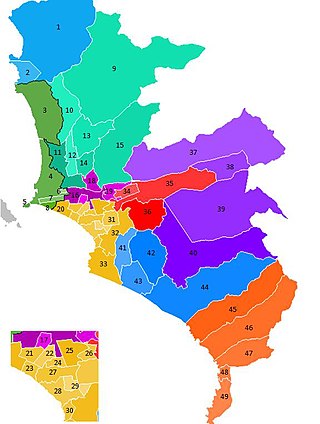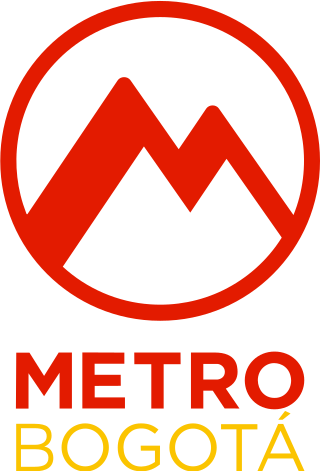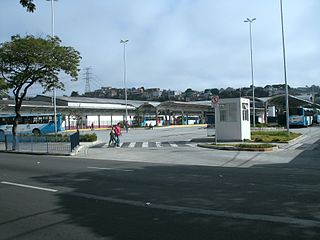
The Lima Metropolitan Area is an area formed by the conurbation of the Peruvian provinces of Lima and Callao. It is the largest of the metropolitan areas of Peru, the seventh largest in the Americas, the fourth largest in Latin America, and among the thirty largest in the world. The conurbation process started to be evident in the 1980s.

The Mexico City Metrobús, simply known as Metrobús, is a bus rapid transit (BRT) system that has served Mexico City since line 1 opened on 19 June 2005. As of February 2018, it consists of seven lines that cross the city and connects with other forms of transit, such as the Mexico City Metro. The most recent line to open was line 7, running for the first time double-decker buses along the city's iconic boulevard, Paseo de la Reforma.

The Bogotá Metro is a rapid transit project under construction in Bogotá, Colombia, it is projected to be in operation in 2028. Construction started in October 2020.

Servicio de Transportes Eléctricos de la Ciudad de México (STE) is a public transport agency responsible for the operation of all trolleybus and light rail services in Mexico City. As its name implies, its routes use only electrically powered vehicles. It was created on 31 December 1946 and is owned by the Mexico City government. STE is overseen by a broader local governmental authority, Secretaria de Movilidad de la Ciudad de México (SEMOVI)(Secretariat of Mobility of Mexico City), formerly (SETRAVI) which also regulates the city's other public transport authorities, including Sistema de Transporte Colectivo, Red de Transporte de Pasajeros del Distrito Federal and Metrobús, as well as other forms of transportation in the district. STE's passenger vehicle fleet consists exclusively of trolleybuses, light rail, and aerial lift vehicles, and in 2007 its network carried 88 million passengers, of which 67 million were on trolleybus services and 21 million on light rail.

Metropolitano is a bus rapid transit system serving the city of Lima, Peru. Its construction began in the year 2006.
Public transport in Lima consists of buses, minibuses, taxis, and mototaxis. Micros are the most common means of public transportation in Lima and many other cities in Peru. There are also more than 100 kilometres (62 mi) of cycle paths in the city.
The São Mateus–Jabaquara metropolitan corridor (Portuguese: Corredor Metropolitano São Mateus-Jabaquara), also called ABD Corridor (Corredor ABD) is a bus rapid transit line in Brazil, linking the city of São Paulo to three neighboring cities, Diadema, São Bernardo do Campo and Santo André, as well as (indirectly) Mauá. Operations started in 1988. Its other name references one letter per city (A for Santo André, B for São Bernardo do Campo, and D for Diadema), the same way the ABC region in Greater São Paulo is named.

The Mexico City Metrobús Line 2 is a bus rapid transit line in the Mexico City Metrobus. It operates between Tepalcates, in Iztapalapa and Tacubaya in the Miguel Hidalgo municipality, in western Mexico City.

The Mexico City Metrobús Line 5 is a bus rapid transit line in the Mexico City Metrobus. It operates between Río de los Remedios in the boroughs of Gustavo A. Madero, in Mexico City's northern limit with the municipality of Ecatepec de Morelos in the State of Mexico, to Preparatoria 1 in Xochimilco.

Diadema–Morumbi Metropolitan Corridor is an intermunicipal bus corridor of 12 kilometres (7.5 mi) corridor of extension that connect the cities of São Paulo and Diadema. Projected and built by EMTU, the line is currently administered by Metra, with an initial demand of 85,000 passengers per day.

Guarulhos–São Paulo Metropolitan Corridor is a 12.3 km (7.6 mi) long bus corridor, with 3 bus terminals and 19 bus stops. When concluded, it will be 20 km (12 mi) long, with 5 bus terminals, and will attend approximately 100,000 daily passengers.

Itapevi–São Paulo (Butantã) Metropolitan Corridor, with 33 km (21 mi) of extension, starts in Itapevi Bus Terminal, connected with CPTM Line 8-Diamond, in Itapevi, and goes to ViaQuatro Butantã station of Line 4-Yellow, in São Paulo. The project reaches the cities of Itapevi, Jandira, Barueri, Carapicuíba, Osasco and São Paulo which total approximately 13 million inhabitants.

A centro de transferencia modal, is a type of transport hub found mainly in Mexico City. Locally known as paraderos, these intermodal passenger transport stations allow commuters to transfer between different modes of public transit, generally between rail and bus systems. In Mexico City, their operations are supervised by Organismo Regulador de Transporte (ORT). Since 14 December 2010, the hubs became part of a decentralized organization. Out of the 40 operative CETRAMs existing in the city, 33 are found adjacent to Mexico City Metro stations.

The Metrobus is the massive bus transportation system that operates in the districts of Panama, San Miguelito and Colón. The system began operations on December 28, 2010, replacing the "diablo rojo" bus system that existed for several decades. It travels the main roads of Panama City, the main toll highways, as well as other minor transversal routes. In Colón the route is from Altos de Los Lagos-city center. The MiBus transport service is expected to be implemented in the Arraiján District and the western sector of the country.

The Mexibús Line III is a bus rapid transit (BRT) line in the Mexibús system. It was the third line to be built and the second to be opened. It operates between Chimalhuacán, in the State of Mexico and Pantitlán metro station in Iztacalco and Venustiano Carranza, in Mexico City. It was inaugurated by the governor of the State of Mexico, Eruviel Ávila on 30 April 2013 with 29 stations. Another station was opened in 2019. In 2023, an extension was added from Chimalcuacán Municipality to Chicoloapan de Juárez. It is 23 kilometers (14 mi) long. The line operates with 85 articulated buses.

The Tarjeta Transporte Público is a payment method for public transport in Madrid, the capital of Spain, and its surrounding autonomous community. Managed by the Consorcio Regional de Transportes de Madrid (CRTM), the body responsible for coordinating public transport in the Community of Madrid, as of 2019 more than 16 million TTPs are in circulation.

The Urban Transport Authority for Lima and Callao is a specialised technical organisation of the Ministry of Transportation and Communications. Its main function is to integrate and articulate urban public transportation in the Lima metropolitan area.

The Integrated Transport System for Lima and Callao is an urban public transportation system that operates in the Lima metropolitan area, made up of the Peruvian cities of Lima and Callao. Its administration is in charge of the Urban Transport Authority (ATU).

Estadio Nacional is a station of the Metropolitano bus system in Lima, Peru. It is located east of the National Stadium of Peru and the Park of the Reserve, receiving its name from the former, between the districts of La Victoria and Lima's Santa Beatriz neighbourhood.

Tacna is a station of the Metropolitano bus system in Lima, Peru. It is located at the intersection of Emancipación and Tacna avenues in the city's historic centre. Due to its proximity to the Sanctuary and Monastery of Las Nazarenas, its service is suspended when the annual Lord of Miracles festivities start in October.



















